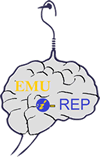Despite the large volume of research in the literature, face recognition remains a hard
problem to solve. The challenge is due to many factors that may affect the performance
of any recognition system such as size of training data, noisy images, accuracy-speed
trade-off, variations in illumination, expressions, or pose, etc. Although there are a
lot of efforts that have been proposed for special conditions, no method exists to work
under unconstrained conditions with satisfactory performance.
In computer vision, human face classification is a very popular and important topic.
This popularity comes from the wide-spread applications of face recognition such as
entertainment, security, and control. Most, if not all, of these applications require
the recognition systems to have low computational complexity and high recognition
accuracy.
In this thesis, three methods are proposed for feature extraction and face
classification. These methods are based on `2-norm regularized regression. The main
idea of these methods is to train a dictionary capable of transforming a face image
into a form that can be used to classify it into its correct class. Image representation in
the transformation domain is a sparse vector with small number of nonzero
coefficients. The goal is to come up with a transformation matrix such that the
sparsity pattern depends on the class of the transformed image. This is accomplished
by regression in addition to regularization terms and constraints. The three proposed
ideas differ in how to attain this goal. The first proposed method uses the idea of
predefined sparse matrix to specify the sparsity pattern of image transformation. The
second method constrains the transformation such that the inner product of the image
transformation is minimized if the images are of different classes, and maximized if
the images are of the same class. The last method transforms the images such that the
nonzero coefficients do not overlap for different class, and the transformation of class
images become close to the transformation of its mean vector.
Several simulation experiments are implemented and executed to test the performance
and competence of the proposed methods. The simulations are performed with
different benchmark face databases. The results prove that our proposed methods are
distinguished over state-of-the-art methods by their accuracy, computational cost and
robustness to image occlusion and corruption
OZ¨:
Onerilen c¸ok sayıda aras¸tırmaya ra ¨ gmen, y ˘ uz tanımanın c¸ ¨ oz¨ ulmesi zor bir problem ¨
oldugu g ˘ or¨ ulmektedir. Buradaki zorluk, e ¨ gitim verilerinin boyutu, g ˘ ur¨ ult ¨ ul¨ u¨
gor¨ unt ¨ uler, do ¨ gruluk-hız kars¸ilas¸tırılması, aydınlatmadaki de ˘ gis¸imler, ifadeler veya ˘
pozlar gibi herhangi bir tanıma sisteminin performansını etkileyen birc¸ok faktorden ¨
kaynaklanmaktadır. Ozel s¸artlar ic¸in teklif edilen kısıtlayıcı olmayan kos¸ullar altında ¨
tatmin edici bir performansla c¸alıs¸mak ic¸in hic¸bir yontem mevcut de ¨ gildir. ˘
Bilgisayarlı gor¨ u alanında insan y ¨ uz¨ u sınıflandırması c¸ok pop ¨ uler ve ¨ onemli bir ¨
konudur. Bu populerlik e ¨ glence, g ˘ uvenlik ve kontrol gibi yaygın uygulamalardan ¨
gelmektedir. Bu uygulamaların tum¨ u olmasa da c¸o ¨ gu tanıma sistemlerinin d ˘ us¸¨ uk¨
hesaplama karmas¸ıklıgına ve y ˘ uksek tanıma do ¨ grulu ˘ guna sahip olmasını gerektirir. ˘
Bu tezde, oznitelik c¸ıkarımı ve y ¨ uz tanıma ic¸in ¨ uc¸ y ¨ ontem ¨ onerilmis¸tir. Bu y ¨ ontemler ¨
l2-norm tabanlı duzenli regresyona dayanmaktadır. Ana fikir, bir y ¨ uz g ¨ or¨ unt ¨ us¨ un¨ u¨
dogru sınıfa sınıflandırmak ic¸in kullanılabilecek bir forma d ˘ on¨ us¸t ¨ urebilecek bir ¨
sozl ¨ uk olus¸turmaktır. D ¨ on¨ us¸¨ um alanındaki g ¨ or¨ unt ¨ u temsili, az sayıda sıfır olmayan ¨
katsayılı seyrek bir vektord ¨ ur. Amac¸, seyreklik modelinin d ¨ on¨ us¸t ¨ ur¨ ulen g ¨ or¨ unt ¨ un¨ un¨
sınıfına baglı oldu ˘ gu s¸ekilde bir d ˘ on¨ us¸¨ um matrisi olus¸turmaktır. Bu, d ¨ uzenleme ¨
s¸artlarına ve kısıtlamalarına ek olarak, regresyon ile gerc¸ekles¸tirilir. Onerilen ¨ uc¸ fikir ¨
bu hedefe nasıl ulas¸ılacagı konusunda farklılıklar g ˘ ostermektedir. ¨ Onerilen ilk ¨
yontem, g ¨ or¨ unt ¨ u d ¨ on¨ us¸¨ um¨ un¨ un seyrek kalıbını belirlemek ic¸in ¨ onceden tanımlanmıs¸ ¨
seyrek matris fikrini kullanır. ˙Ikinci yontem, g ¨ or¨ unt ¨ uleri farklı sınıflarda ise g ¨ or¨ unt ¨ u¨
don¨ us¸¨ um¨ un¨ un ic¸ c¸arpımının en aza indirgenmesi ve g ¨ or¨ unt ¨ ulerin aynı sınıfta olması ¨
halinde en ust d ¨ uzeye c¸ıkarılması s¸eklinde d ¨ on¨ us¸¨ um¨ u sınırlar. Son y ¨ ontem, sıfır ¨
olmayan katsayıların farklı sınıflar ic¸in c¸akıs¸madıgı ve sınıf imajlarının d ˘ on¨ us¸¨ um¨ u¨
ortalama vektor¨ un¨ un d ¨ on¨ us¸¨ um¨ une yakın hale gelece ¨ gi s¸ekilde g ˘ or¨ unt ¨ uleri d ¨ on¨ us¸t ¨ ur¨ ur. ¨
Onerilen y ¨ ontemlerin performansını ve yeterlili ¨ gini test etmek ic¸in c¸es¸itli sim ˘ ulasyon ¨
deneyleri uygulanmıs¸ ve sonuc¸lar uretilmis¸tir. Sim ¨ ulasyonlar, farklı y ¨ uz¨
veritabanlarında gerc¸ekles¸tirilmis¸tir. Sonuc¸lar, onerilen y ¨ ontemlerin son teknoloji ¨
yontemlere g ¨ ore do ¨ gruluk, hesaplama maliyeti, g ˘ or¨ unt ¨ u tıkanıklı ¨ gı ve bozulmaya olan ˘
saglamlı ˘ gı ile ayırt edildi ˘ gini kanıtlamaktadır.









